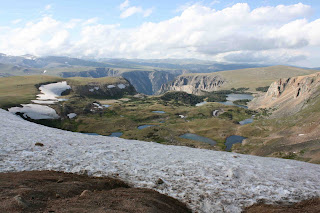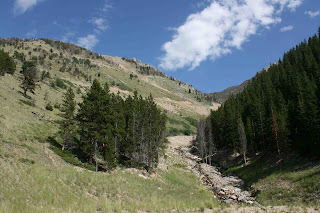





Little Bighorn/Beartooth Pass/Yellowstone Park
I spent about 13 hours driving between Wyoming and Montana. Slept last night in Sheridan, Wyoming near Bighorn. The aim was to get as close as possible to Little Bighorn National Monument, which happens to be 70 miles north into Montana.
After Wounded Knee I was eager to visit Little Bighorn, which brought significant change in relations between American Indians and the federal government. Lt. Colonel George Armstrong Custer's defeat in June 1876 signaled a turning point in bringing American Indians to submission, pacification and dependency.
Little Bighorn's site was more elaborate than Wounded Knee's, which is located on a reservation near the Badlands in South Dakota. I asked a park ranger why there was no plans to develop the Wounded Knee site, and his response was that it was up to the American Indians to decide, and the subject was still raw enough for them that moving from the past seems difficult. Indeed it did feel that way with Richard, the American Indian I met at Wounded Knee two days ago. Maybe it will take time, but at least there's some progress. At Little Bighorn, a separate memorial was built more than a decade ago to recognize the American Indians who died in battle.
Little Bighorn had a trail that marked sites of historical significance such as key battles between the two sides. As a park ranger remarked, this site hasn't changed at all since the battle 134 years ago.
Montana's landscape is pretty much desolate, with the Great Plains still extending toward this area, the state's nickname appropriately is Big Sky. At the Mammoth Site in South Dakota, a guide mentioned that the region is North America's version of Africa's serengeti, which makes sense. The drive across Montana lasted a few hours, before returning southward toward Wyoming and Beartooth Pass, which has the highest elevated roadway in Yellowstone Park.
Some friends suggested traveling the road, and I wasn't disappointed. The winding road reminded me of the switchbacks of Mountain Province in northern Luzon. And reaching an elevation of almost 11,000 feet, I was amazed of the view -- glaciers, lakes, barren rock and lush vegetation. Traveling from the hot lowlands to a relatively cool 48 degrees Fahrenheit in a matter of hours is pretty spectacular. And yes, I did manage to walk toward a glacial spot and feel the coolness of that ice.
The road down took longer because of construction, but worth the trip. Moving into Yellowstone Park would also take a few hours to get to the hotel in Gallatin Gateway, where I am now, and with the sun setting, I was lucky enough to witness spectacular views of valleys and peaks.
A stretch of valley revealed herds of bison (aka buffalo), and it was my first time to view them, at relatively close range. Lots of firsts today, and it was a pretty good adventure. The road at sunset getting out of the park was also great -- got to see a geyser, streams, and more peaks and valleys. Life does have its ups and downs...
So was it our suggestion to go over Beartooth pass? :) When and if you reach any glaciers in Glacier NP, you need to take a sample of remaining ice and store in the freezer. Then in the future you can claim to have the last remaining glacier held in captivity.
ReplyDelete